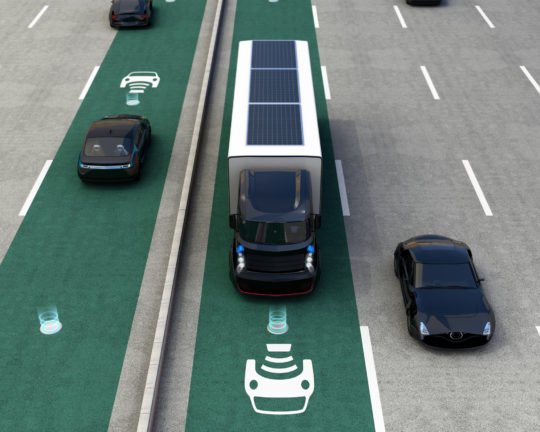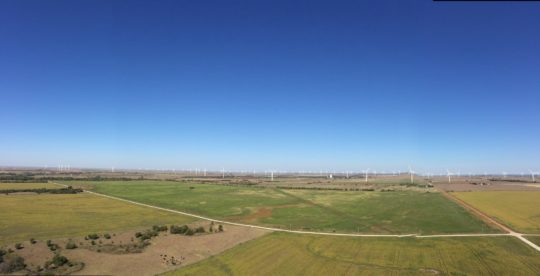The Road Map to Decarbonization
Big changes are needed in four key areas to create future markets, enable long-term planning and investment, and provide a new “north star” for our economy.
Every day, Apex works to decarbonize the grid, bringing utility-scale wind and solar projects to life across nearly two dozen states. But achieving our mission, and stopping or reversing the effects of climate change, will require us to think bigger, broader, and more long term.
The Union of Concerned Scientists has calculated that we need to be building five times as much wind and solar every year as we do today to achieve carbon neutrality by 2050. That’s why we’re developing a Road Map to Decarbonization to educate the market on the roles we all need to play to get the job done.
The Road Map focuses on four key areas: federal carbon policy, transmission, project siting, and electrification. It’s the type of thinking required to create future markets, enable long-term planning and investment, and provide a new “north star” for our economy.
Carbon Policy
One of the most impactful trends encouraging climate change mitigation is the cost competitiveness of clean energy. It’s the result of a confluence of factors: tax incentives have helped accelerate market demand, which in turn have supported supply chain growth and technology advancement, creating a virtuous cycle.
The reality, however, is that wind and solar must compete head to head with fossil fuels, but oil and gas are subsidized in a way that is permanently written into the tax code. To make things worse, they pollute without penalty. These two factors combined create a massive advantage favoring the past over the future.
In lieu of a federal carbon policy, many states are committing to be 100% clean or renewable by 2050 or sooner. It’s often said that the states are the nation’s laboratory for policy, and we are seeing it in action.
While the production tax credit and investment tax credits that support renewables have served their purpose, they also stand today as the only proxy we have for a price on carbon or a national renewable energy standard. We need a federal policy on carbon that sets a new, level playing field—one that doesn’t distort the market like the PTC and ITC—and that provides clear and lasting signals to investors and power consumers that we are all helping build a clean energy future.
In the meantime, states are enacting their own policies related to electricity and the utility sector, many committing to be 100% clean or renewable by 2050 or sooner. This has shifted the conversation and created real momentum, and we applaud the courage and commitment these laws require. It’s often said that the states are the nation’s laboratory for policy, and we are seeing it in action.
Transmission
Today, the difference between a clean energy project coming to fruition or staying on the drawing board is often its ability to inject power into the interconnection grid and for that power to be distributed where it’s needed. This wasn’t a problem in the early days of wind and solar, because lower-voltage transmission could handle the power with minimal upgrades. As we’ve scaled up in size—both in the number of projects and the megawatts per project—the grid is struggling to keep up.
Congestion issues plague the hubs closest to the best wind and solar resources, which distorts the market and prevents growth. The lack of high-voltage transmission lines, such as those successfully deployed in Texas but struggling to get off the ground elsewhere, hurt the industry’s ability to connect the massive, still-untapped potential of wind and solar to industrial centers and major cities.
We need to move beyond regional transmission planning to interregional cooperation and have all the work guided by a federal vision. It’s the fastest route to realizing tremendous increases in the cost-effectiveness of renewables and scaling to where we need to be to meet the Paris climate targets. States will struggle to meet their new carbon goals without a national plan. Similarly, we will be ill-equipped to handle the next wave of demand from corporations when industries such as manufacturing begin to follow the technology sector’s lead.
Project Siting
An incredible amount of scientific and technical research goes into where we place—or “site”—a wind or solar farm. It’s not just about the resource, in terms of where the sun shines brightest or where the wind blows consistently strong. It’s also closely tied to the communities that host the projects, and how the infrastructure and the revenue it provides both coexist with and improve the quality of life for the people who live nearby.
But rules vary state by state and locality by locality, and national opposition has focused on using politics to inflame debate in small towns. These conditions have often made it hard for well-meaning local leaders to make smart policy and for clean energy developers to build the projects necessary to decarbonize the grid. Even in states where aggressive carbon goals have been set, the politics have made it so that the time required to gain regulatory approvals often exceeds developers’ ability to keep a project ready to finance and build.
The path forward? Everyone involved in the energy transition needs to do more to educate leaders at the federal, state, and local levels to speed permitting-process reform. Once there is broader agreement on the clear local economic impact, the science on health and environmental impact, and the increasingly important role of the clean energy supply chain across all 50 states, we can help county commissioners and other community leaders do what’s right—for their families, their neighbors, and all of us working to fight climate change.

Electrification
Electrification is how the utility sector contributes to the decarbonization of other sectors of the economy, and it is key to our success.
The commercial transportation sector—the fleets of tractor trailers and delivery trucks that keep goods and services flowing across the country—is our low-hanging fruit, as EVs and electric trucks are already beginning to lead the way. The next major priority is the industrial sector, including the production of products like cement, steel, ammonia, and fertilizer. The good news? Carbon solutions already exist across every one of these areas.
The challenge is how to make change more rapid and more economical for business. Again, certain states are taking leadership positions in the creation of incentives, such as New York and Illinois, which both have renewable energy credit (REC) programs to help foster entrepreneurial solutions. Combined with the growing availability of clean energy, these are essential components needed for success. But how we help companies lower the risk of being first movers, or investing in innovation at scale, is where our work can be done. After all, you can lead a horse to water …
The Road Ahead
The primary focus of Apex will continue to be the development and operation of large-scale clean energy projects. But our mission demands that we do more. The Road Map that we are building out will take more than a few years, and certainly longer than any one election cycle, to guide us to our destination. It’s the same long-term strategies and discipline to stick to a plan that have helped the oil and gas industries fight change for so long. All of us working toward a clean energy future must follow suit.
To the extent we can help those leading at every level of government and throughout the private sector understand our shared challenges and goals, we will dedicate time and effort to do so. The time to act on climate is now, and every single one of us has a role to play.



